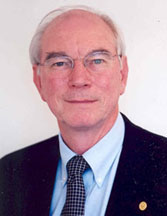PMEL Director Dr. Eddie Bernard Earns Service to America Medal

Dr. Eddie Bernard, Director of NOAA’s Pacific Marine Environmental Laboratory
Dr. Eddie Bernard, Director of NOAA’s Pacific Marine Environmental Laboratory in Seattle has become the first NOAA scientist to be awarded a Service to America Medal (SAM) for his work in establishing an international tsunami detection and forecast system.
“This is big time,” Bernard said. “There are many worthy people who were nominated for this award and I’m humbled by this recognition.”
“This is where NOAA research really shines,” said retired Navy Vice Adm. Conrad C. Lautenbacher, Ph.D., Undersecretary of Commerce for Oceans and Atmosphere and NOAA Administrator. “The tsunami work is an excellent example of science in service to society, combining technology, knowledge, and innovation to create a system to warn people of impending danger.”
Bernard won in the Homeland Security category, one of the seven SAM categories presented by the Partnership for Public Service. The award ceremony took place Sept. 16 in Washington, D.C.
As PMEL Director, Bernard oversees a broad range of oceanographic research programs, but the tsunami work has been the focus of his own research for most of his career. He served as Director of the Pacific Tsunami Warning Center in Hawaii, published more than 70 papers, articles and reports about tsunamis and served as chairman of the National Tsunami Hazard Mitigation Program, a joint federal-state effort, from 1997 to 2004. He serves and has served on many international and national panels and boards.
“The problem has always been that the existing technology only provided a forecast of when a tsunami would arrive at a coastline, not the intensity or duration once it arrived,” Bernard said.
He experienced this problem first hand while serving as Director of the tsunami warning center and dedicated his research to develop an accurate forecast.
The key to a tsunami forecast was accurately measuring a small change in the deep sea that could be identified as a tsunami and then transmitting these data in time to be useful. That led to the creation of the tsunami detection and forecast system now in use in the United States and along the Pacific Rim.
A team of scientists and engineers devised the Deep Ocean Assessment of Tsunamis, or DART, a deep ocean tsunami detection system that provides essential data that can be incorporated into computer models for accurate tsunami forecasts.
The DART systems consist of an anchored seafloor bottom pressure sensor and a companion moored surface buoy for real-time communications. An acoustic link transmits data from the bottom pressure sensor on the seafloor to the surface buoy. The data are then relayed via satellite link to NOAA's Tsunami Warning Centers, the National Data Buoy Center, and PMEL.
The system took years to perfect. But in 2003, it was right on target when it detected a tsunami resulting from a 7.5 earthquake in Adak, Alaska. The State of Hawaii saved about $68 million by not issuing an evacuation order for its coastal residents, based upon the information from the buoy system that the resulting tsunami would not be a large one. The tsunami wave that made it to the Hawaiian shore was less than a foot high. “It worked as it was designed to do,” Bernard said in 2003.
Following the December 26, 2004 Indian Ocean tsunami, which killed more than 228,000 people, NOAA’s tsunami technology became the standard for development of tsunami warning systems throughout the world.
Since 2004, there have been seven more tsunamis in the Pacific Ocean that were detected in real time and used to compute experimental forecasts. The forecast accuracy has been 90% as compared with tide gauge data in 12 different U.S. harbors. This accurate forecast system is now being installed at both of NOAA’s tsunami warning centers in Hawaii and Alaska.
A tsunami is a series of ocean waves generated by any rapid large-scale disturbance of the sea water. Most tsunamis are generated by earthquakes, but they may also be caused by volcanic eruptions, landslides, undersea slumps or meteor impacts.
Service to America Medals have been presented annually since 2002 by the nonprofit, nonpartisan Partnership for Public Service to celebrate excellence in our federal civil service. More than 3,000 public servants have been nominated for the award since its inception.
Watch a video of Dr. Bernard discussing the tsunami system at: http://www.oar.noaa.gov/podcast/
September17, 2008
